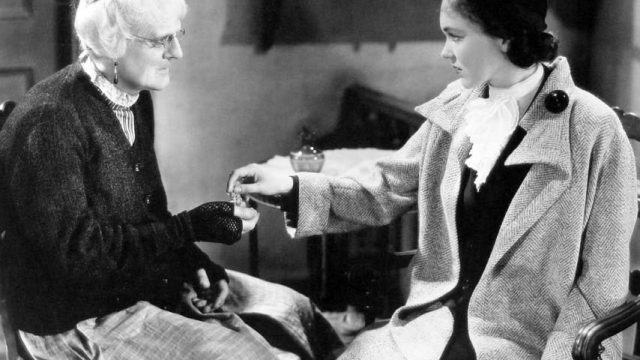What if someone could shrink people to the size of dolls, but in doing so, lost all their higher brain functions so they had to be controlled psychically by their creator? And what if somehow, against the laws of movie tropes, the person doing all of this was the hero of the film?
Such is what we get in 1936’s The Devil-Doll, which may be my favorite Tod Browning. We open with Paul Lavond (Lionel Barrymore), framed for embezzlement by his partners at their Parisian bank and fleeing prison with his cellmate, the scientist Marcel (Henry B. Walthall). Evading the dogs and swamp boats (and the feeling of, “Do they have bogs like this in France or are they just reusing sets set from some predecessor of Gun Crazy?”) they make it to Marcel’s house, where his wife Malita (Rafaela Ottiano) awaits. Turns out Marcel (and we never learn why he was in jail, but I think we can assume it’s on the level of “meddling with things no man was meant to meddle with”) has been developing technology to shrink living beings to doll size. As mentioned before, they then have no free will of their own and have to be ordered about, both verbally and telepathically.
Lavond, quite reasonably, objects to this, especially after Marcel shrinks their maid Lacha (Grace Ford). He regards it as an abomination against man and God. But hey, it’s already done and it’s irreversible and wouldn’t you know it, during the argument Marcel has a heart attack and dies. Nothing for Lavond and Malita to do but pack up and head to Paris where Lavond can use the dolls to exact revenge on the three partners who framed him and took away his life.
Now here’s where we get to the odd conceit of this movie, wherein Lionel Barrymore spends, oh, 75% of the movie dressed us a little old lady to throw off suspicion as he prowls around Paris, ferreting out his former partners, as well as his daughter, who is resentful of the father she thinks is a terrible criminal. For 1936, it’s a surprisingly good bit of cross-dressing, far better than something like Tootsie. Lionel looks like he is having a ton of fun playing a little old lady, everyone deferring to her as she pokes into everyone’s business.
Naturally, Lavond clears his name with the assistance of the dolls, but there the movie gets really interesting. Lavond declares his name is cleared but he cannot come back because of the crimes he committed to do that and that he and Malita should destroy the technology so no one else can use it for evil. He literally says that it’s an evil technology that he has been using for good but it was a one-time deal and no one else should, like the cell phone-monitoring tech in The Dark Knight. It’s such an interesting take on it, that he doesn’t want to take over the world or anything so tropish; he completed his quest and his daughter is safe.
Unfortunately, Malita objects because she wants to continue and complete Marcel’s work. There’s a big fight, things explode and Lavond walks off into the sunset, but not until a scene on the top of the Eiffel Tower where Lavond reveals himself to his daughter and tells her why everything happened. And this is why, of all of Tod Browning’s movies, I love this the most. Here we have someone who is responsible for death and paralysis and mayhem over weeks in Paris, and yet somehow Lionel is making us give a damn about him and his relationship with his daughter. Like a lot of the great horror movies, you give a damn about the supposed villain, but this is one of the early ones for that.
It’s an odd little movie that I highly recommend; outside of Drew’s occasional work these days, I think we’re forgetting how good the Barrymore family actually was and how much Lionel was the standard bearer when it came to the screen. Watch him in this and marvel at how much more he is than just Mr. Potter in It’s A Wonderful Life.

